Original URL: https://www.theregister.com/2011/06/30/hands_on_hp_touchpad/
HP TouchPad 9.7in WebOS tablet
The true alternative to Android and Apple?
Posted in Personal Tech, 30th June 2011 09:42 GMT
Hands On HP has learned from Apple. Not simply by mimicking - or judging it to be the correct size in any case - the iPad's 9.7in screen defined dimensions, but by avoiding the obvious operating system: Android.
Hardware being what it is, the only true way to differentiate your product is the user experience, and WebOS allows - as iOS does for Apple - HP, not another company, to define it. Google seems less keen on permitting UI overlays on Honeycomb tablets than it has on smartphones, so it's going to become ever harder for vendors to avoid offering 'me too' Android products.
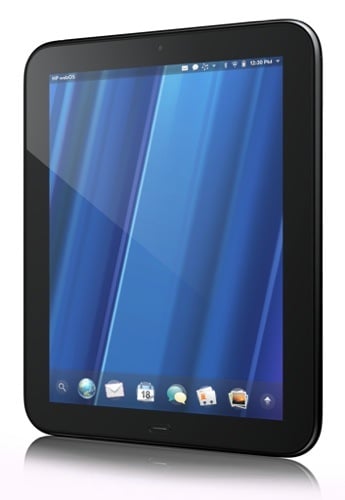
HP's TouchPad: the design shows an iPad inspiration
Beyond the branding, there's not an awful lot of difference between, say, a Motorola Xoom, a Toshiba Thrive and a Samsung Galaxy Tab 10.
But back to the HP TouchPad, which I got to play with at a launch bash last night. I'll talk more about WebOS 3.0 shortly. First, the hardware.
In your hands, the TouchPad feels thicker and weightier than the original iPad let alone the iPad 2. The specs may say there's not much in it, but that's how it feels.
The gloss-black plastic casing looks good, but has a cheaper feel than the iPad's metal - a matt material might have been better.

The black hides the 3.5mm headphone port and Micro USB port on the base. Like the iPad, there's no memory card slot, or other connectors. It does have stereo speakers on the left side - which becomes the bottom when a video is played, automatically flipping the tablet into landscape orientation.
There's a volume rocker switch on the right side. The power key is on top. Facing you, above the portrait screen, is a 1.3Mp webcam, essentially the only hardware feature the TouchPad has that the original iPad lacked.
The screen is, as I say, an iPad-like 9.7in capacitive job with a 768 x 1024 resolution. HP gets my thumbs up for that - the 4:3 ratio is the ideal for tablets, I think. Yes, widescreen is good for video - no letterboxing - but it's a fail when you use the tablet in portrait orientation. The 4:3 ratio feels right in both modes.
In the subdued, smoky lighting - hence the lack of snaps - of HP's launch venue, the TouchPad's screen looked less crisp than Apple's. Alongside a pounding PA system, the speakers, backed by the HP-inevitable Beats Audio tech, could barely be heard, so I won't judge those qualities. But I can say the touchscreen felt less sensitive than those of other tablets, though some of the lag is surely down to the TouchPad's CPU and graphics.
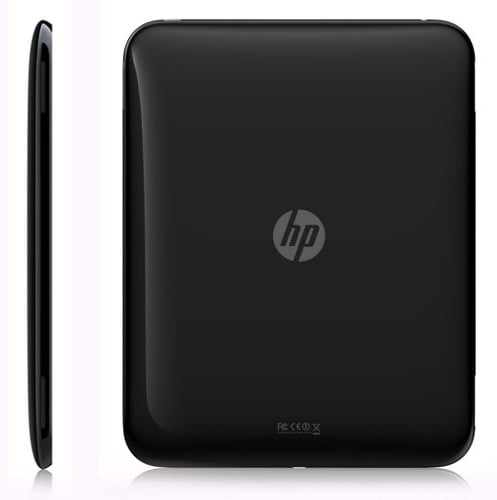
No (unnecessary) camera on the back
The TouchPad may sport what Qualcomm calls a "dual CPU" chip, the 1.2GHz Snapdragon APQ8060, but it feels tardy alongside more recent, nippier models with dual-core chippery. My first-gen iPad feels smoother.
HP makes much of WebOS' multi-tasking, which puts simulataneously running apps' windows in a line across the screen. Swipe from one to the next, but when you get to the end of the line, you don't automatically go on to the first - the line isn't 'circular' - you have to swipe all the way back.
The WebOS experience
Apps can be selected from a dock of favourites along the bottom of the screen, or by entering an Android-like screen of Apps, which sits alongside Downloads, Favourites and Settings tabs. App store downloads, therefore, sit separate from built-in software, unless you move the lot to Favourites. Each setting is implemented as an app.
Tapping an app pops you back to the main screen and a new window is added to the line. You can move the line while the app is loading, which isn't an instant process by a long chalk. Some apps take a good few seconds to load. It feels longer, in part because all you have is a rotating symbol for feeback.
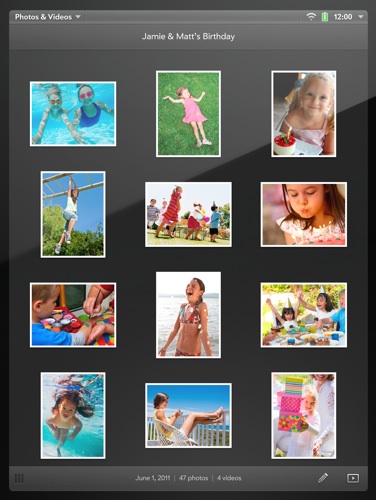
Photos are photos - whether they're stored online or on your tablet
At the top of the screen is WebOS' "Just type..." bar, a universal search field along the lines of iOS' Spotlight search, finding not only strings in contacts and such, but also app and settings names.
Apple could do a better job of integrating search - even iOS 5 keeps it off to one side - or maybe Apple figures folk so rarely perform searches it doesn't need to be up front. I very rarely use Spotlight, since each app makes it easy enough to find what I'm after, and I know whether a name is a contact's moniker, Twitter handle, a place where a meeting scheduled to take place, or is an app.
I suspect the WebOS' Just Type, powerful though it is, will be similarly used infrequently.
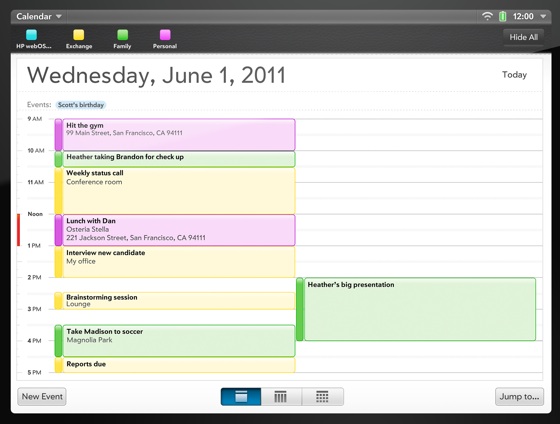
Your info is always available in the cloud
iOS 5 will prove crucial in any judgement punters make between iPad or TouchPad. HP was keen to make my try WebOS' unintrusive notifications. Yes, they're better than iOS 4's alternative, but iOS 5 fixes that.
But even iOS 5 doesn't integrate social networking and other communications channel to the degree WebOS does. This is the HP OS' real strength: it treats Twitter, Facebook, LinkedIn, even Apple's own MobileMe - though that will morph into iCloud soon enough - as services, not apps. Likewise email systems such as MS Exchange, Yahoo!, Hotmail, Gmail and such.
This is a key philosphical difference between the two operating systems, and one reason why WebOS is way more cloud-centric than iOS. The Photos & Videos app, for instance, doesn't simply present side-loaded content, it shows you your pics from Facebook, Flickr etc., too.
It's saying you don't need to know where you pictures are kept, all that matters is that you can look at them when you want to.
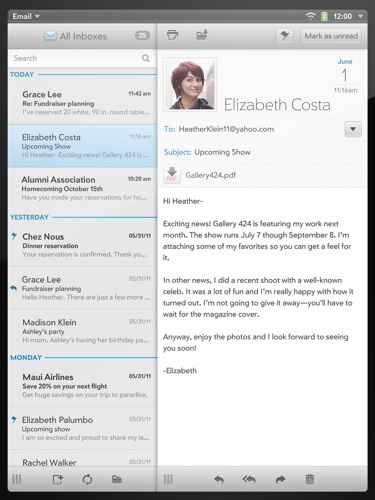
WebOS has pre-loaded support for multiple mail services
Likewise, why fire up a separate app to make a Facebook post or send an IM about a site you're viewing in the - Adobe Flash-equipped, natch - browser? iOS' multi-tasking makes flipping between these apps quicker than it used to be, but it's still taking an app-centric approach. WebOS has a more task-centric view, and it feels more modern.
So too is its ability to communicate with HP's WebOS 2.0-based smartphones, though given how few folk own one, this may prove less of a selling point than HP seems to think.
Online service centric
Touching phone's rear HP logo to the TouchPad's Home button auto-pairs the two, and future taps let them sync screens. View a website on your TouchPad, touch phone to pad, and the phone will immediately open its browser and present the page you're viewing. New Pres can be used as cellular modems in the same fashion.
It's cute, but limited to WebOS 2.0 and 3.0 devices.
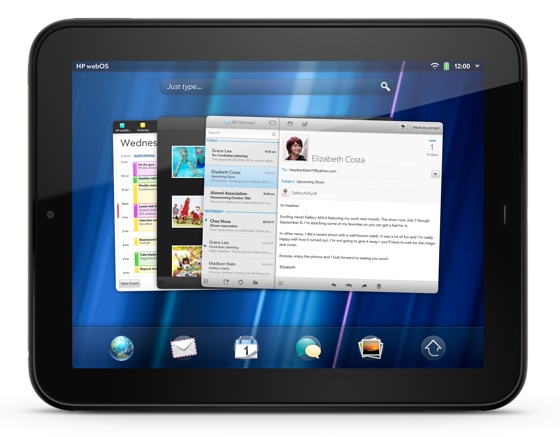
Running apps are represented as 'cards' - tap one to bring it to the fore
Touchstone is more useful - HP's Palm-developed inductive charging system is built into the TouchPad. The charging dock-cum-stand is an optional extra, but it'll be a compelling purchase for TouchPad owners, offering wireless charging in whatever orientation you slip the tablet onto it.
The downside - no syncing cable - isn't really a negative: you'll sync your data wirelessly using the TouchPad's 2.4GHz and 5GHz 802.11n Wi-Fi link. It'll only be a handicap if you side-load content frequently.
HP said there will be 6000 apps available for the TouchPad when it goes on sale here on 15 July. That probably includes Pre-oriented apps, presented in a window or full-screen if they're capable of supporting it.
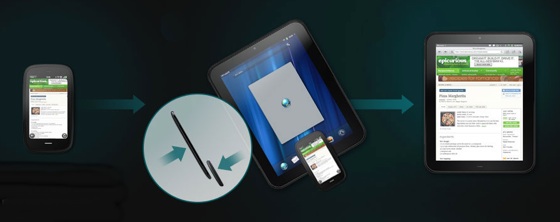
Tap phone to pad to sync screens. Yes, it works - but you have to have a Pre
Comparing the number of apps available to different platforms is an invidious now as it was in the Windows vs Mac battles of the 1980s and 1990s: quality is far more important than quantity, and the jury is still out on that one.
HP is paying [surely, 'persuading' - Ed] some big names to create apps for the platform, and if it can build up a solid userbase, more will come of their own volition.
And that's key: selling the TouchPad and selling WebOS. Today's world is one where data is platform agnostic, so it shouldn't matter what OS you favour. App availability can change that, but HP is big enough - as Palm was not - to pick up the tab in the near term.
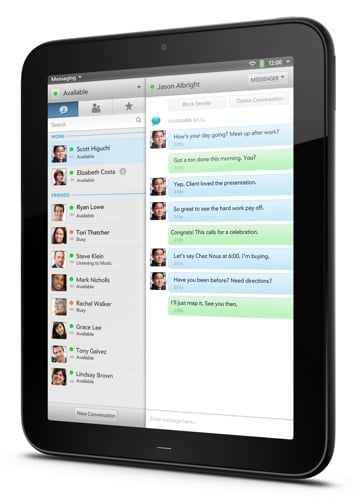
Multi-service messaging is at the heart of WebOS
The TouchPad isn't the mythical 'iPad killer' - no tablet yet available is. But it's worthy alternative, especially if while disapproving of Apple's walled garden, you don't particularly trust Google either.
That said, while I like WebOS, the hardware is a let-down. It's not actually bad, but alongside the likes of the iPad 2 and Asus Eee Pad Transformer - let alone the anticipated iPad 3 - it feels like a product that's just behind the curve - the performance isn't quite there. ®
Tablet Reviews |
||||
 Asus Asus
Eee Pad Transformer |
Iconia Tab A500 |
 RIM RIM
BlackBerry PlayBook |
 Motorola Motorola
Xoom |
 Apple Apple
iPad 2 |